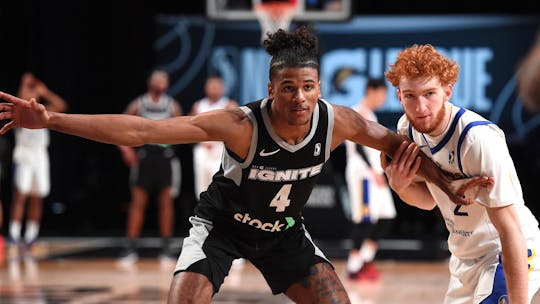But for scouts, looking at how a top prospect responds to the pressure that the March Madness stage offers is valuable information. From Carmelo Anthony's championship run at Syracuse to the birth of “Cardiac” Kemba Walker to Gordon Hayward and the Butler Bulldogs’ two-year odyssey, top prospects can raise their stock significantly with a good performance in college basketball’s biggest stage.
This year, no player boosted his stock more than Jalen Suggs in the tournament. Suggs, who was already seen as a Top 5 prospect before the college season, was key in the Gonzaga Bulldogs' 34-game winning streak. In the 34th win, Suggs earned his one shining moment, drilling a game-winning triple from near half-court to beat the UCLA Bruins.
JALEN SUGGS. UNBELIEVABLE! 🤯🚨@ZagMBB #FinalFour pic.twitter.com/QeEAjENYmG
— NCAA March Madness (@marchmadness) April 4, 2021
Gonzaga was routed in the Finals by a determined Baylor squad, but scouts had seen enough to start raving about Suggs' potential. Gonzaga already had one of the best programs in the U.S. for two decades. Showcasing Suggs elevated them to a near-unbeatable machine. Suggs was Gonzaga's high-flying emergency button that was only activated when senior Corey Kispert or sophomore bigman Drew Timme was having an off game.
Before the college basketball season, scouts questioned Suggs' ceiling. They saw him more as a sure-fire bet to become a veteran guard in the NBA with his 6-foot-4, 205-pound frame and his all-around skillset. During March Madness, Suggs had a lot of huge games as Gonzaga's main option, showing that he could possibly be a top option on an NBA rotation and not just a top-level role player.
If Suggs is rising on the draft board, where does that leave Filipino-American prospect Jalen Green of G League Ignite? Why does it even matter where they are drafted?
Fans shouldn’t be concerned about how much basketball players make because they make A LOT regardless of role. But draft positioning does affect how much of the rookie scale figure a team can sign a draftee for. The higher they get picked, the more they can make immediately. It’s great for the players and their agents.
The biggest concern should not necessarily be when a player is picked, but which team picks the player. Most top-flight draft picks end up on teams years away from making the playoffs. That type of environment doesn’t always foster the best environment for development. Just look at how good Donovan Mitchell was for the Jazz in his first season, coming into a playoff team looking for their next perimeter star.
Between the two Jalens, Green is projected as a player that has All-Star potential and could most likely break out after a few seasons on a good team. Playing in the G League exposed Green to near NBA-level coaching and opponents. He showed that he can already be an elite scorer in the NBA with his speed, handles, and leaping ability. That part of his game is not just potential. It’s already there.
.@JalenGreen closed out the 2021 campaign with a season-high 30 PTS 🔥 pic.twitter.com/Q23HovX1lV
— NBA G League (@nbagleague) March 8, 2021
What scouts also found in Green's G League stint is his lack of production everywhere else. Like a lot of young, athletic scorers, Green struggled to find the best pass in a possession, whether he was driving or initiating the play. He's a frisky defender, but some are questioning whether his 6-foot-4, 180-pound frame can hold up against bigger NBA wings.
Green was already behind elite playmaker Cade Cunningham and nimble big Evan Mobley on almost all major public draft boards. The Suggs hype may have pushed Green as the consensus fourth pick.
With Suggs, scouts see an impact player right from his first season. Almost all teams need a Suggs type on their team – someone comfortable with taking a back seat on offense and still significantly contribute defensively. The NBA comparison for him is Jrue Holiday, one of the most underrated stars in the league who's been a winning player since his time in Philadelphia.
Green is more of a project with a potential massive payout. His most encouraging comparison has been Zach LaVine, someone who needed five years and a change of scenery to realize his potential as an All-Star. Like Green, LaVine’s weaknesses were his court vision and passing, skills he's had to tirelessly develop over the years. Green has also been compared to guys like Terrence Ross and Malik Monk. These are solid NBA players, but maybe not the inspiration we'd want for the first Filipino-blooded lottery pick. But even if Green falls from the Top 3, what we really should hope for is that he gets drafted by the right team.




